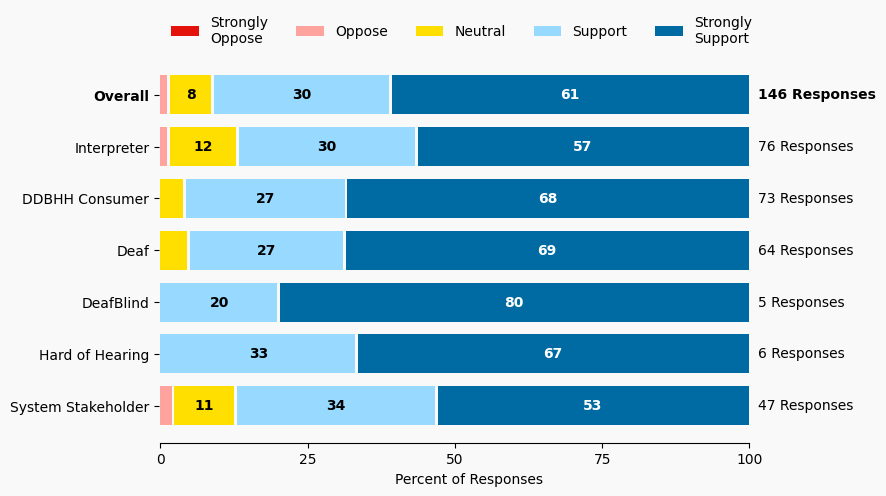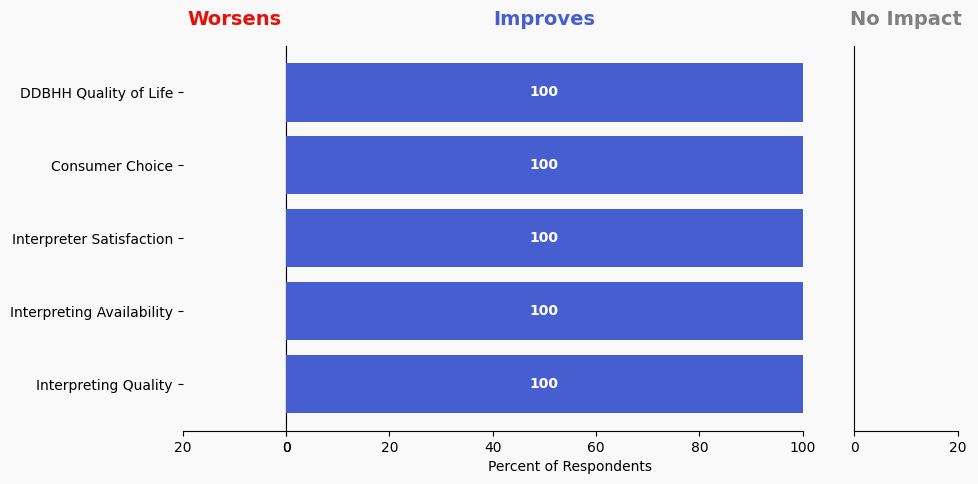5 Educate All Entities on ADA Responsibilities and How to Access Interpreters
Issue: All organizations who need to hire interpreters often do not understand how to obtain quality and qualified interpreting services
Proposed Solution: Coalition, with Commission and State Services leading, develop a working group of consumers, customer experience representatives and interpreters to compile a list of frequent entities where DDBHH people are seeking interpreters. This working group can compile a list of targeted entities and make publicly available documents to educate entities of their responsibilities for providing interpreters, as well as resources to secure interpreters and guides on what they can expect. Example service providers are state and local government service providers, private businesses, non-profit organizations, medical and legal providers. A system of “Deaf-Friendly” certificates could be developed. The entity can earn the “Deaf-Friendly” designation, display the certificate and be included in a database so DDBHH community members can make choices about where to go.
Expected outcome: DDBHH people will experience more and better services when interacting with any employers and public servants.
Who is impacted: Interpreters, consumers
Update 9/7/24: The Employer Reasonable Accommodation Fund includes employer education and advice on the ADA. See their website at https://mn.gov/deed/business/ficing-business/eraf/. State Services has a wealth of information for entities wanting to hire interpreters on their website at https://mn.gov/deaf-hard-of-hearing/communication-access/interpreter/.
Timeline: 6 months

Summary of Support Image Description
The stacked bar charts show how respondents rated their level of support and the total number of responses. The percentage for the five support levels is shown from left to right: Strongly Oppose (Dark Red), Oppose (Light Red), Neutral (Yellow), Support (Light Blue), and Strongly Support (Dark Blue).
Respondents may identify with multiple subgroups. The overall level of support is:
Overall
Strongly Oppose: 0%
Oppose: 1%
Neutral: 8%
Support: 30%
Strongly Support: 61%
Click to see the detailed image description for each subgroup.
Interpreter
Strongly Oppose: 0%
Oppose: 1%
Neutral: 12%
Support: 30%
Strongly Support: 56%
Deaf
Strongly Oppose: 0%
Oppose: 0%
Neutral: 5%
Support: 27%
Strongly Support: 69%
DDBHH Consumer
Strongly Oppose: 0%
Oppose: 0%
Neutral: 4%
Support: 27%
Strongly Support: 68%
DeafBlind
Strongly Oppose: 0%
Oppose: 0%
Neutral: 0%
Support: 20%
Strongly Support: 80%
System Stakeholder
Strongly Oppose: 0%
Oppose: 2%
Neutral: 11%
Support: 34%
Strongly Support: 53%
Hard of Hearing
Strongly Oppose: 0%
Oppose: 0%
Neutral: 0%
Support: 33%
Strongly Support: 67%
Overview of Respondents Opting for In-Depth Solution Analysis
After indicating their support level, 4% of the 146 respondents opted in to further assess whether the solution would worsen or improve on five metrics. Of the opt-in reviewers (6 respondents), 100% supported the solution, 0% were neutral on the solution, and 0% opposed the solution.
The remaining 140 respondents did not opt in to further assess the solution. Of these people, 90% support the solution, 7% were neutral on the solution, and 1% opposed the solution.
Reviewer Evaluation of Solution Effectiveness

Solution Effectiveness Image Description
The stacked bar charts show how respondents assessed the effectiveness of this solution based on five metrics. For each metric, the percentage of respondents is shown from left to right: Worsens (Red), Improves (Blue), No Impact (Gray).
DDBHH Quality of Life
Makes It Worse 0%
Makes It Better 100%
No Impact 0%
Interpreter Satisfaction
Makes It Worse 0%
Makes It Better 100%
No Impact 0%
Consumer Choice
Makes It Worse 0%
Makes It Better 100%
No Impact 0%
Interpreting Availability
Makes It Worse 0%
Makes It Better 100%
No Impact 0%
Interpreting Quality
Makes It Worse 0%
Makes It Better 100%
No Impact 0%
Reviewer Feedback and Insights
Interpreter
No comments were submitted.
Deaf, DeafBlind, Hard of Hearing
Comments from DDBHH Consumers expressed support and suggested providing a communication template that can be used by consumers to send resources.
System Stakeholder
No comments were submitted.
PREVIOUS SOLUTION
4 Educate Potential Hiring Entities & Employers: ADA Responsibilities
Issue: Organizations who need to hire interpreters often do not understand how to obtain quality and qualified interpreting services
NEXT SOLUTION
6 Commission Host Self-Advocacy Training via Online Videos
Issue: More online training resources are needed for consumers.
Leave a Reply